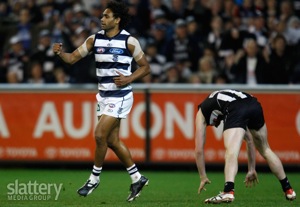
Travis Varcoe of Geelong celebrates during the AFL 2nd Preliminary Final between the Geelong Cats and the Collingwood Magpies at the MCG.
Michael Cockerill has written a few articles recently in the SMH offering his full support to Lowy and the FFA in its bid to host the World Cup in 2018 or 2022.
The most recent article focuses on the receipt of government funding, and the assertion that the AFL has somehow gained from the direct receipt of Government funds.
Cockerill says: “AFL has received about $453m from the three tiers of government.”
That is false. A quick search of the AFL’s annual reports going back to 2003 shows no such receipt of Government funds.
At best, Cockerill has used language extremely loosely (and don’t forget that he is a professional journalist), at worst, he has been misleading.
But now I come to the main point: no-one North of the Murray should ever pretend that they understand the history of Australian Football, ground usage and the Government’s role unless they really, really, honestly do understand it.
And that would mean having been part of the generations upon generations that have lived it and breathed it as part of their day-to-day lives.
The relationship between Australian football and cricket is a long one – a very long one – going right back to the inception of the game 151 years ago.
By a quirk of history, the game began to use cricket grounds, at first not consistently, but slowly and surely, the game was played on a cricket oval, and the shape of the ground would soon become an oval.
This quirk of history meant that almost from the very start, cricket was the senior partner in ground sharing – so virtually all the ovals that were ever used by senior football clubs were cricket grounds owned and controlled by cricket clubs.
However, by the mid 1860s, we had the anomalous situation where cricket owned and controlled the grounds – but Australian Football brought in the money to maintain them – a pattern repeated right across Southern Australia.
But I’ll limit my discussion to Victoria.
Every club in the VFA, then the VFL, played on a cricket ground – and virtually every VFA/VFL club existed alongside an eponymous cricket club, such that Footscray Football Club played at the Footscray Cricket Ground, shared with the Footscray Cricket Club, Melbourne played at the Melbourne Cricket Ground, Essendon played at the Essendon Cricket Ground.
And so it went on.
The cricket clubs owned and controlled the facilities, but Australian football paid for them, paid for the upkeep, paid for the improvements, and pretty much subsidised cricket for 145 years (give or take).
How?
Quite simply Australian Football has always had the large crowds and gate receipts at club level, and cricket never has – not even close.
Ever wondered why the MCG is five times the capacity of Lords? Thank Australian Football.
Now, in the mid 1960s (pretty much 100 years on from where we first started our story), the then VFL had had a gutful of effectively paying for a ground (the MCG) that it didn’t own or control – and thus started a long, ambitious journey to full independence that continues to the present day.
The VFL purchased some land (a sizeable chunk) in the outer south-eastern suburbs of Melbourne, called Waverley. It was ambitious in the sense that it was the very largest football stadium ever built (perhaps on the face of the Earth in terms of dimensions), only ever got to a capacity of some 86,000 odd (can’t quite remember the exact figure), but the initial plan was to one day have a stadium that far surpassed the capacity of the MCG.
The idea was that the day would come when the VFL would play its own grand final on its own ground, and pocket millions upon millions of dollars that were otherwise leaving the game every year (and had been from day one).
Why didn’t the VFL proceed with this audacious plan?
Because the then Cain government stepped in, and one way or the other, was going to force the VFL to remain at the MCG against its will and against its commercial interests.
Yes, people, far from being an aide to the VFL, at that very moment the Government was being an obstacle to complete financial independence!
Eventually, after years of negotiations, threats of legal action, etc. a settlement was reached, and the MCG remained the home of the grand final, was further developed – and has continued being enhanced to the present day.
This little story also helps explain why when Australian Football makes a deal with the MCG.
It is a very long one!
While the relationship has been good to the AFL over the last 18 years (but still with its problems in terms of sharing revenue) – there’s little doubt that without Australian Football, the MCG would not be the stadium we have today – it has not been one way traffic.
In the meantime, the AFL eventually sold its interests in Waverley, and ultimately initiated the construction of the Dome at Docklands, another audacious project, which it will own outright in 2025.
This project was built with no funding from Government, that is, 100 percent private equity.
So when people North of the border start telling stories about Australian Football, grounds and Government, they better get their story straight or they will end up looking like a dill.





























































































